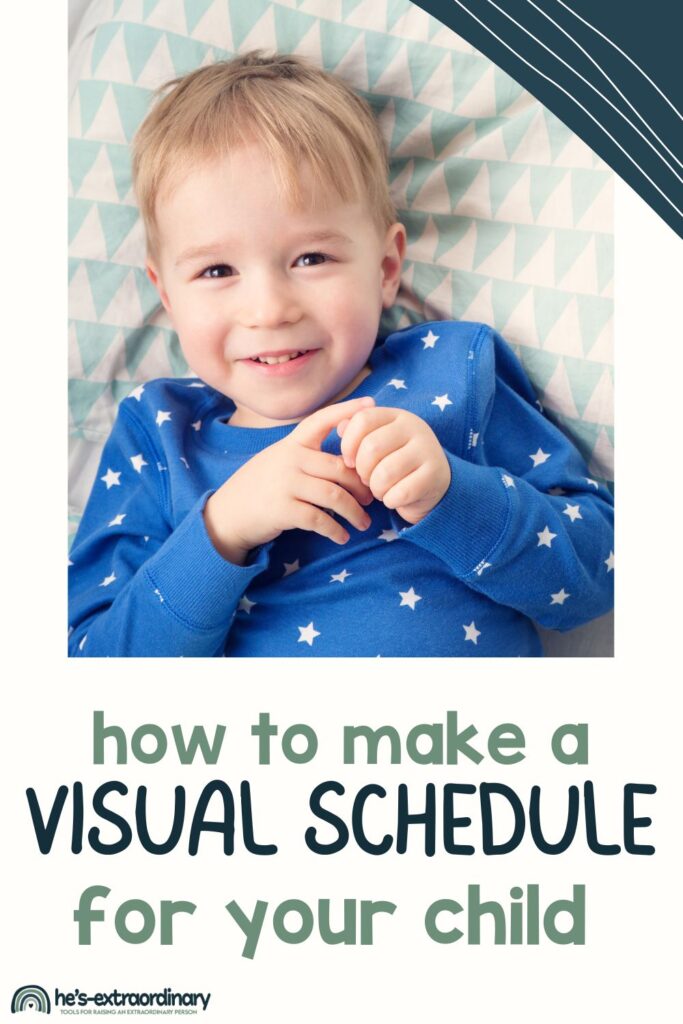Why Kids Need Routine & How to Make a Visual Routine for Your Home
What’s inside this article: A step-by-step guide to creating a daily routine with visuals that your child actually follows. The benefits of daily routines for kids, and tips for sticking to your routine.
Everyone touts using a visual schedule for children to give them structure and routine. But if you’ve never used one before, you might be wondering how to make a visual schedule for your home.
Where do you even start?
Benefits of a Daily Routine & a Visual Schedule
It’s pretty simple – children need structure in order to thrive. One of the easiest ways to add structure to their life is by creating and following a daily schedule.
Visual schedules are beneficial for all children. But, they can be particularly helpful for children with autism, ADHD, or anxiety.
Some benefits of visual schedules include:
- A visual schedule can easily be understood, even by children who can’t yet read or who are nonverbal.
- Not knowing “what’s next” is often a source of anxiety for kids. Even if their routine is consistent, they may still worry about this. With a visual schedule, they can easily look to see what to expect next.
- It helps establish healthy, constructive habits – such as personal hygiene and completing chores and homework daily.
- Provides stability – uncertainty may cause major stress for kids with autism. This usually stems from not having a full understanding of how the world works.
- Encourages independence because your kids don’t need to come to you asking what to do constantly.
- The home is the easiest place to teach kids long-term habits, and a visual schedule can facilitate that.
- Helps with the development of some executive functioning skills, such as time management and organization

How to Plan Your Daily Routine
Before making the actual visual schedule itself, you must first plan what your daily routine and the kids’ daily routine will look like.
Most likely, some parts of your daily routine are already established, like dinner time and bedtime. But if you have a lot of gaps in your day that are chaotic or have no apparent plan, then it can be hard to decide what you want to do with that time.
It’s a good idea to jot down a few habits that you’d like the family to adopt as part of their day, for example, everyone cleaning their rooms each day.
Then, you can start planning those habits in your day.
Creating your Daily Routine & Visual Schedule Step-by-Step
- Write down what already happens every day
The best way is to begin by writing down your schedule, starting with what already happens every day and at approximately that time. These should include dinner, waking up, bath time, going to school, bedtime, etc. - Fill in the gaps
Fill in the gaps by deciding on more structured activities for your child for specific times. Instead of telling them to “go play,” you can add activities like – outdoor play, fine motor play (crafts, drawing, cutting, beading, etc.), quiet time, etc.
It doesn’t have to be a specific activity that they do every day because that can get very boring. But, for example, if you designate 3 pm-4 pm for craft time, then you plan different tasks each day or a week at a time. - Structure the environment
Set up specific areas in your home where each of these activities will happen, and get any supplies you need. For example, set up your craft table, get a bin and fill it with homework supplies and set up a homework station. Build a calm-down space and anything else you want to create. - Decide how to initiate transitions.
Decide how you will transition between activities on the schedule – will you use a timer? A verbal cue? A sound warning? A song?
Each activity needs a clear start and finish. This helps children know when it’s time to move on. Plus, this transition cue should be consistent between every activity. - Create the schedule visually
There are many different ways to do this. You can also make this yourself – draw it by hand or create it by finding your own images online and printing them. (I’ve created a visuals pack with 12 drag-and-drop templates and 140 graphics. Learn more here.)
Whatever you choose, make sure the visuals are clear for your child to understand and that everything is concise and consistent. - Display your schedule
Place the visual schedule in a central location in your home, such as the fridge or in the family room. Ensure it’s in a location that makes it easy for yourself and your kids to check the schedule. In the beginning, you will probably need to remind your kids of the schedule all the time. - Teach your child to follow the schedule
It’s not enough to make it and hang it up on your fridge – you need to actually teach your child the routine. This is the most important part.
This can take time and may require a lot of prompts and reminders in the beginning. You can’t deviate from the schedule once it’s set – your visual schedule is like a contract between you and your child.
Once the routine is familiar to your child, you can begin using strategies to prepare your child for changes in the schedule, such as a change calendar.
A Good Visual Schedule Will:
- Depict the activities that will occur and in what sequence
- Show transitions within the day (like changing activities or environments)
- Promote independence
- Can be created for the whole day or broken up into chunks. For example, you could have a morning routine and an after-school routine)
Visuals for Your Daily Routine/Schedule
You’ll need to find visuals to use with your schedule that are easy for your child to understand. To simplify this, I created a digital download with 12 drag-and-drop visual routine templates and 140 premium graphics. You can add whichever graphic you want and edit all of the text to suit your individual needs.
There is also an easy-to-follow tutorial included.
Are Your Mornings Chaotic?
If mornings are chaotic in your home, and you’re looking to use a visual routine to help reduce the stress before school, you may also be interested in the Morning Magic Mini Workshop.
This Workshop includes the graphics and visuals for creating routines, plus a 20-minute workshop for stress-free mornings.
The Morning Magic Workshop will share with you the three keys to a stress-free morning and provide you with all the tools needed to transform mornings in your home completely.
This is something you can complete and easily implement in under an hour.
Tips for Sticking to Your Schedule
Now that you have a well-planned visual schedule, here are some tips for sticking to it.
- Make sure your child’s schedule is compatible with your schedule so that it will be easy for both you and your child to stick to the daily schedule.
I have reminders on my phone, and the kids’ schedule and my schedule change at the same time. - Ideally, the schedule should include a combination of both structured and unstructured activities. Children should have a combination of both.
Include time when they should play independently, for example, a quiet time each afternoon. - You don’t have to have the whole day on a single schedule. You can split it up and have a morning schedule and an afternoon schedule if that works better for your family.
- If your child struggles to follow the displayed routine, make a copy for them as a checklist, laminate it, and have them actually carry it with them around the house and check off the items with a dry-erase marker. When my kids wake up, the first thing I do is pass them their lists. It’s made our mornings completely stress-free.
- Suppose your child has extracurricular activities or appointments that change frequently. In that case, you can make the schedule with Velcro on the visuals so they can be moved around every day or have different schedules for different days of the week and swap them out.
If the schedule changes often, go over it with your child the night before and again in the morning. - Make adjustments when needed. Your schedule won’t stay the same as the seasons change, your child gets older, during school breaks, etc.
It’s okay to make adjustments when they need to happen but try to keep a mostly consistent routine over time.


